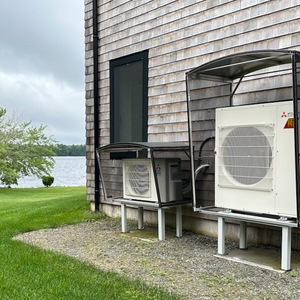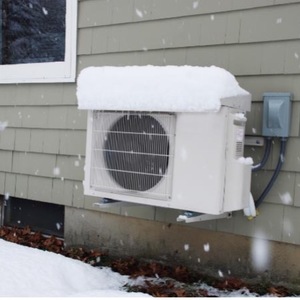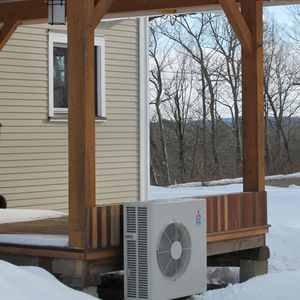
Heat pumps need to be elevated to keep them from being blocked by snow and to allow meltwater produced during the defrost cycle to drain away. Without adequate drainage, the meltwater can refreeze, clogging or damaging the unit. In a previous article, I looked at mounting options, including wall brackets and ground-mounted pads and stands.
While most of the frost that forms on the heat pump’s outdoor coil comes from water vapor in the air, liquid water can also add to the moisture load. The heat pump’s design shelters the coils from vertical rain, but wind-driven rain, splattering raindrops, and blowing snow landing on the coil can increase the frequency and length of defrost cycles.
Under normal circumstances, the extra moisture added by precipitation is modest, as is the impact on performance. But roofs can concentrate runoff from rain and melting snow at drip lines below eaves. Placing a heat pump under an eave can lead to ice buildup on the coil. If the ice becomes too thick, the system may not be able to clear it during the defrost cycle. Airflow drops, as does heat output. If the buildup continues, the system may shut down completely.
Snow sliding off metal roofs also poses a risk. A large mass of snow can bury, dent, or knock a heat pump out of level. In one case I know of, sliding snow ripped linesets out of their fittings, leading to a complete loss of refrigerant.
The best way to avoid problems with sliding snow, concentrated rain, and snowmelt is to keep heat pumps away from eaves and roof valleys, placing them instead on gable ends or under deep overhangs. When this isn’t possible, a protective awning or shield may be needed.
A few years ago, it was difficult to…
Weekly Newsletter
Get building science and energy efficiency advice, plus special offers, in your inbox.

This article is only available to GBA Prime Members
Sign up for a free trial and get instant access to this article as well as GBA’s complete library of premium articles and construction details.
Start Free TrialAlready a member? Log in















4 Comments
Heat pumps in cold climates are not new, my 1978 built home in Minneapolis had one originally. The panel has a 50-amp breaker labeled "heat pump". When we bought the house in 1993 the heat pump served as AC only and the heating was with a GE gas forced air. All was converted to a high efficiency Lennox system in 2007. Would dearly love to know about the first years with that heat pump and was the gas furnace original as backup heat.
Doug
At that time heat pumps were only efficient down to about 40 degrees and inoperable below freezing. Lots of northern houses were built with them anyhow. These generally had electric resistance coils for backup, as do many modern cold climate heat pumps. Even cold climate units have lower limits for operability and efficiency. Even though electric resistance heat is expensive, the thought is that it's not used all that much. Although I've got to think that backup heat would have been used a lot in Minneapolis.
Curious to know what you think of https://airdeko.com/
We installed them on our new build to cover LG pumps.
They are a nice looking product, and the sound baffling could be beneficial. My main concern is that having louvers right in front of the fan might impede airflow, which could cause a number of problems. These might only show up in extreme conditions. I guess I'd like to see a letter from the heat pump manufacturer stating that the cover was approved for use with their products, or, barring that, some third-party test results.
Log in or become a member to post a comment.
Sign up Log in